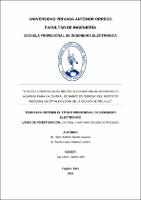| dc.contributor.advisor | Llanos León, Lenin | |
| dc.contributor.author | Hueda Zavaleta, Oscar Antonio | |
| dc.contributor.author | Palacios Carrión, Marlon Jason | |
| dc.creator | Hueda Zavaleta, Oscar Antonio | |
| dc.date.accessioned | 2018-01-31T13:11:25Z | |
| dc.date.available | 2018-01-31T13:11:25Z | |
| dc.date.issued | 2016 | |
| dc.identifier | T_ING.ELECT_793 | |
| dc.identifier.other | T046_44845184T | |
| dc.identifier.other | T046_42762016T | |
| dc.identifier.uri | https://hdl.handle.net/20.500.12759/3522 | |
| dc.description.abstract | El presente trabajo de investigación se centra en realizar un diseño de un sistema de
monitoreo y alarmas para la central de banco de oxígeno del instituto regional de
oftalmología de la ciudad de Trujillo.
En el Primer Capítulo del presente trabajo, se aborda la problemática que ocasiona el
desabastecimiento de oxígeno en el banco de oxígeno del Instituto Regional de
Oftalmología de Trujillo. En él exponemos nuestro objetivo y damos a conocer la
importancia de dar una solución debido a lo crítico que es que el banco de oxígeno
quede desabastecido antes, durante y después de las operaciones que se llevan a cabo en
la institución.
En el Segundo Capítulo, se presenta el marco teórico y un sustento valido del porqué la
elección de realizar un diseño de sistema de monitoreo y alarmas para el banco de
oxígeno del instituto regional de oftalmología de Trujillo y también reforzar la solución
que estamos proponiendo.
En el Tercer Capítulo, se procede con el estudio de las posibles tecnologías y desarrollo
de la solución, detallamos los equipos y accesorios utilizados para lograr los objetivos
trazados.
En el Cuarto Capítulo mostramos los resultados de nuestro diseño en cuanto a las
pantallas con las cuales el usuario interactúa para monitorear el estado del banco de
oxígeno.
Y en los últimos dos capítulos mostramos una breve discusión de nuestros resultados y
las conclusiones a las que llegamos. | es_PE |
| dc.description.abstract | In the first chapter of this work, the problems caused by the shortage of oxygen in the
oxygen bank Regional Institute of Ophthalmology Trujillo addressed. In it we expose
our goal and we present the importance of a solution because of how critical it is that
the bank remains undersupplied oxygen before, during and after the operations carried
out in the institution.
In the second chapter, the theoretical framework and a valid support why the choice of
making a system design monitoring and alarms for oxygen bank regional institute of
ophthalmology Trujillo and strengthen the solution we are proposing is presented.
In the third chapter, we proceed with the study of the possible technologies and
development of the solution, we detail the equipment and accessories used to achieve
the objectives.
In the fourth chapter shows the results of our design in terms of screens with which the
user interacts to monitor the status of bank oxygen.
And in the last two chapters we provide a brief discussion of our findings and
conclusions arrived. | en_US |
| dc.description.uri | Tesis | |
| dc.format | application/pdf | es_PE |
| dc.language.iso | spa | es_PE |
| dc.publisher | Universidad Privada Antenor Orrego | es_PE |
| dc.rights | info:eu-repo/semantics/openAccess | es_PE |
| dc.source | Universidad Privada Antenor Orrego | es_PE |
| dc.source | Repositorio institucional - UPAO | es_PE |
| dc.subject | Sistema de Monitoreo | es_PE |
| dc.subject | Banco de Oxígeno | es_PE |
| dc.title | Estudio y propuesta de diseño de un sistema de monitoreo y alarmas para la central de banco de oxígeno del instituto regional de oftalmología de la ciudad de Trujillo | es_PE |
| dc.type | info:eu-repo/semantics/bachelorThesis | es_PE |
| thesis.degree.level | Titulo Profesional | es_PE |
| thesis.degree.grantor | Universidad Privada Antenor Orrego. Facultad de Ingeniería | es_PE |
| thesis.degree.name | Ingeniero Electrónico | es_PE |
| thesis.degree.discipline | Ingeniería Electrónica | es_PE |

